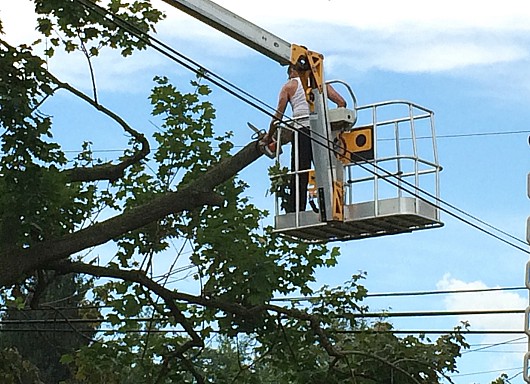Tree Removal: Homeowners Step-By-Step Guide

We love trees! Healthy trees are a beautiful part of the landscape and the crowning touch to your yard. But sometimes a tree is no longer in the best of health and may even be hazardous. In that case, you will have to think about tree trimming or removal. Find out the steps in deciding which action is right for you and how to get great professional tree service to take care of the problem.
- Inspect your tree. Is the tree badly damaged, decayed, diseased, or infested with bugs? Does there appear to be imminent danger to people, cars, homes, or other trees in the area? Is any part of the tree in contact with electrical wires? Are the tree roots damaging pavement or plumbing pipes? Could the tree be considered a fire hazard? In all these cases, you’ll need the help of an experienced professional tree service.
- Check responsibility. Investigate whether tree removal is your responsibility. Your municipality is usually responsible for trees growing on public property. When there’s a hazardous tree in a neighboring yard, things get dicey. Normally, the law permits you to trim a tree (roots as well as branches) up to your property line … as long as you don’t prune drastically enough to cause irreparable harm. Tree removal is up to your neighbor, though you can file a nuisance claim if you’re afraid the tree is about to fall onto your property.
- Find a tree service. It’s fine to comparison shop for tree removal prices … but remember that time (not to mention skill) is of the essence when there is danger to either life or property involved. Make absolutely sure your contractor is licensed, with up-to-date insurance for both liability and workers’ compensation … his crew will be doing dangerous work.
- Decide on the best way to go. Would tree trimming be sufficient or is complete tree removal the best course of action? A reliable arborist will let you know whether your tree can be saved, and what that would involve. Sometimes, a simple tree pruning will remove the problem area and your tree will go on to live may more happy, healthy years. In other cases, tree removal may be necessary for safety reasons.
- Pull a permit. Yes, you read right. In some cities, you will need to pull a permit before cutting down trees. Tree removal permits are often required for the following: certain species or sizes, designated “heritage trees,” or trees in specific locations, such as next to a roadside or near the ocean shoreline. Removal of a diseased tree may require a compliance agreement as well.
- Alert your neighbors. Be a good neighbor and let everyone in your vicinity know when the tree service will be coming. The tree company will be making a lot of noise outdoors for a period of several hours. Obtain written permission in advance if the crew will need access to your neighbors’ property. After the work is done, make sure the company doesn’t leave any debris in the area.
- Watch the crew at work. If you’re home when the tree service company comes to your property, do take some time out to watch them on the job. A top notch tree service crew hard at work is quite a sight to behold. The manager of a Northern California RV park described his professional tree removal as “poetry.”
- Dispose of the tree. Agree with your tree service contractor ahead of time what will be done with the remains and whether this service is included in the price. He can cut the tree up into firewood; chip it to use as mulch for your garden; or in the case of disease or infestation, haul it to the dump. You may opt for stump grinder service, as well. If you prefer to let the stump decompose on its own, it could take as long as 10 years.
Laura Firszt writes for networx.com.
Looking for a Pro? Call us (866) 441-6648

Average Costs
Related Experiences

Oak Tree Planting Looks Great In Our New Home’s Spacious Yard

Don’t Be A Goober – Hire Qualified Pros For Safe Tree Removal



